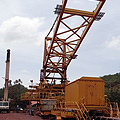APRON VERSUS VIBRATING FEEDERS: WHAT ARE THE DIFFERENCES?
April 18, 2017
Down in an industrious mining or quarrying complex, powerful feeders are conveying extracted material. They’re carrying the discharge, transporting the raw rocky stuff to a final destination. Curiously, the raw discharge can be conveyed by two feeder types, the apron feeder or a vibrating feeder. In making an intelligent choice between the two, we need to put on a showdown, a matchup that assesses the major differences between these two popular feeder solutions.
THE VIBRATORY FEEDER RIVALRY
It’s not a true rivalry, not when the vibratory feeder is built for certain applications. Designed to carry material while conducting an initial sort, this oscillating machine uses additional motor drives to shake the conveyance deck. It’s ideally suited as a dry aggregate sieving solution, a mechanism that screens gravel and crushed rock. Incidentally, this isn’t always the best feeder mechanism for a line that discharges small particulate matter, since the shaking action can cause clogs. Similarly, muddy aggregate discharges will not bend easily to a simple vibratory mechanism.
SUBSTITUTING THE APRON FEEDER CANDIDATE
This robust mechanical backbone expedites matters when shock loads are on the cards. It works effortlessly as a high-tonnage, high volume flow facilitator. Built to emulate primary crusher housings, the mechanism drives the coarse rocks forward while providing an armoured interface, a moving deck that’s as sturdy as it is versatile. Indeed, an apron feeder looks more like a tractor tread than a conveyance system. Its tread patterns easily accommodate abrasive blocks of ore, all while using a resilient plated belt profile that can carry wet or dry materials with equal efficacy.
CALLING THE RESULTS
There’s no clear cut winner in this contest. A vibrating feeder is a sieving mechanism, so some in-transit processing is evident. Still, the shaking decks can throw fine material into the air instead of carrying out a sort cycle. It’s really best suited for gravel and sized aggregate, materials that are dry and already sorted. In the meantime, an apron feeder is a resilient chain link in the mining and quarrying transportation chain. It operates with abrasive torrents, accommodates water and ice, plus it won’t buckle if the discharge requires a high-tonnage workflow.
Essentially, both feeder solutions are equally capable, but only if they’re used in an application that suits their unique features. The true decision, then, comes when that application is considered, for both feeder mechanisms have pros-and-cons, benefits and disadvantages that only come to the fore when the right application is selected. Use the above features, match them with the situation’s processing needs, and choose the right feeder for that application.
Optimized by: Netwizard SEO


